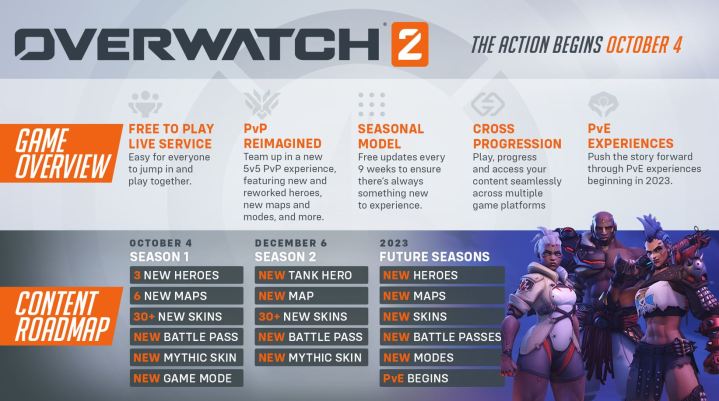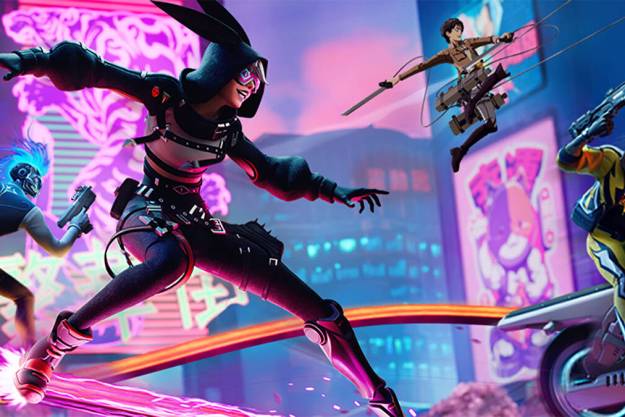Overwatch 2 is going free-to-play this October. The upcoming competitive shooter from an embattled Activision Blizzard was expected to launch in 2023, but we learned that it was coming a bit earlier than expected and would be free during the Xbox & Bethesda Games Showcase on June 12. Still, this is a shocking shift for one of Blizzard’s biggest franchises and one that has a lot of implications for the pace of updates and new content.
Ahead of a livestream that gives more details about the free-to-play shift, Digital Trends spoke to some members of the development team, including Game Director Aaron Keller and Overwatch VP and Commerical Lead Jon Spector, to learn why exactly the Overwatch 2 team decided to embrace free-to-play.
The best option
At launch on October 4, Overwatch 2 players can expect three new heroes (including a support character teased in the release date trailer), six new maps, over 30 new skins (including a mythic skin for Genji), the Push game mode, and the game’s first battle pass. Barring any issues that cause the team to reschedule, the second season will begin on December 6 and introduce another new tank, a new map, and a battle pass with over 30 new skins. More heroes, maps, modes, and the PvE story campaign will start to roll out throughout 2023.
Blizzard plans to make seasons last nine weeks, with three or four new heroes added yearly. If you play games like Apex Legends or Valorant, this cadence of releases should be familiar to you. Keller and Spector claim that other successful free-to-play games aren’t what caused Blizzard to make this shift. Instead, they say factors like lowering the barrier of entry for interested players and not wanting to hold on to finished content played a part in Overwatch 2 going free-to-play.

“We don’t want to develop things and try to pool it together into a big box release; we’d rather just put content out when it’s ready and do it as quickly as we can,” Keller says. “As we kept working on some of the more innovative gameplay for the PvE side of Overwatch 2, it meant that it was going to take longer for any of our PvP features to go public. We want to release stuff as frequently as we can, but it was taking us too long to be able to get it in front of our players.”
The original Overwatch has floundered since it stopped getting significant content updates in 2020 so Blizzard could focus on Overwatch 2. By releasing the sequel as a free-to-play game this year, that long wait ends — and players won’t have to worry about it happening again for a long time. The developers also stressed that Overwatch 2 would feel more like a sequel than an update when it launches, thanks to the new content and rework into 5v5 matches. Spector explains that many systems fell in place simultaneously, like cross-play, cross-progression, and the seasonal model, so it made sense to lower the barriers to entry and launch free-to-play this year.
“We are dedicated to putting out content frequently and consistently in perpetuity.”
“There are a bunch of these different systems that come together to make us feel like this is the right moment to go free-to-play and drop any barrier to entry for players and make it as easy as possible to get in, fall in love with the game, and play with their friends,” Spector says. “It’s really been much more about growing that value of the game and the social aspects of it, and a little bit less about that there’s a ton of content here and could have been a $60 box. That’s really not how we’ve been thinking about it.”
That said, Keller was also honest about the fact that being able to monetize Overwatch 2 as a free-to-play title will also ensure the developers have the funds and support to keep creating new content for the foreseeable future. With battle passes, mythic skins, and an in-game shop confirmed, Blizzard will undoubtedly monetize Overwatch 2 like a cosmetic-driven free-to-play game.
“Quite frankly, we are dedicated to putting out content frequently and consistently in perpetuity, and the easiest way to fund something like that is with a free-to-play style game,” Keller says. “It allows us to continue to build new things for the game.”

Sustaining that vision
Blizzard has a history of running free-to-play live service games like World of Warcraft, but this free-to-play approach is brand new for the Overwatch team. The original was a paid release with significant content updates every few months. But with a free-to-play game, Keller understands that Overwatch 2 will consistently need updates to keep players engaged every day, week, and season. Keller also recognizes that the most successful free-to-play games “put out as much content as they can and to really commit to that” from both a release cadence and team structure standpoint.
“We’re restructuring parts of the team so that we’re able to work on multiple heroes and multiple maps at one time…”
A hectic year of development ensued to ensure the same was the case with Overwatch 2. “We made this big switch, and it has been a really fast-paced year where we have had to do a lot of things to turn this massive ship that was going in one direction in another direction in order for us to fulfill one of our key values for the game, which is to be able to continually update it,” Keller says.
Keller’s comment regarding the significant shift within the last year raises questions about the developers’ health as it made this massive shift during a very turbulent time for Blizzard. Keller says Blizzard took measures to grow the team so it could work on more things at once without stretching itself too thin.
“We’re three times the size we were when we launched the original,” Keller says. “We’re restructuring parts of the team so that we’re able to work on multiple heroes and multiple maps at one time, all while still looking at bigger features that are coming later to the service, such as PvE.”

While Overwatch 2’s free-to-play announcement might have come as a shock for the community, Keller and Spector clarified that this is something they’ve put a lot of thought into and is not a brash decision. Of course, releasing as a free-to-play early access game does mean they can end the series’ content drought and garner as many new players as possible. Still, Spector believes Blizzard’s Overwatch 2 free-to-play overhaul was “thoughtful” and not just done to get something out of the door.
“You need to have a thoughtful strategy for how you’re updating the game and how you’re bringing new content in,” Spector says. “For us, it was really important that it was not just ‘Hey, Overwatch 2 is free-to-play,’ but rather ‘Overwatch 2 is free-to-play, and that is one part of the overall live service vision with seasonal content updates.'”
Overwatch 2 will launch on PC, PS4, PS5, Xbox One, Xbox Series X/S, and Nintendo Switch on October 4.
Editors' Recommendations
- Every rumored video game console: Nintendo Switch 2, PS5 Pro and more
- Sea of Thieves confirmed for PS5 as Xbox details multiplatform rollout
- 2023 gaming report card: how did PlayStation, Xbox, and Nintendo score?
- This breezy 3D platformer wears its simplicity as a badge of honor
- The Lord of the Rings: Gollum is unintentionally delightful




